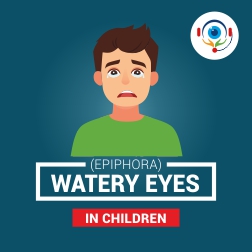Epiphora (Watery Eyes)
Disease
When a child experiences an overflow of tears or watery eyes, it leads to an eye condition that is known as Epiphora.
Causes
Watery eyes are a symptom of innumerable medical conditions like common cold, blocked tear duct, infections and allergies. Let's look into each of these in detail.
1. Common Cold
Watery eyes are among the many symptoms of the common cold.
Children are more prone to catching a cold because they frequently touch their nose, mouth and eyes. By doing so, they spread germs. Another reason why they easily catch a cold is their immune system which isn't as developed as that of adults.
2. Blocked Tear Duct
Blocked tear duct is basically a condition in which tears find it difficult to move from the corners of the eyelids to the ducts that line the nose. This condition can cause tears to remain in the eyes.
Watery eyes are one of the most common symptoms of blocked tear duct.
Having blocked tear ducts is a common phenomenon among infants because in many of them either the tear duct membrane does not open or the opening may be too narrow. However, this condition gets rectified by itself in about 90% of infants by the time they turn 1.
3. Infections & Allergies
Conjunctivitis or Pink Eye is an eye infection that occurs when a virus or bacteria enters the eye and causes the eye to water.
During childbirth, a mother can pass on an infection (chlamydia or gonorrhea) to her child, even if she doesn't experience symptoms. This puts newborns at risk of developing conjunctivitis.
Much like eye infections, watery eyes is a common symptom of allergies. Eye allergies are caused due to allergens like pollen, dust or smoke. Allergic Rhinitis also known as Hay Fever causes watery eyes.
Diagnosis
If you notice that your child is experiencing watery eyes, it is advisable to take your child to the doctor. A doctor's visit will help diagnose what is causing your child's eyes to water.
Treatment
With watery eyes, you don't need to do much to treat it because it is something that gets cleared on its own. However, if an infection is causing watery eyes, you may need to take your child to the doctor to get prescribed medication. Below are two treatment options for watery eyes.
Home Remedies
1. Blocked Tear Ducts - As mentioned earlier, blocked tear ducts normally heal on its own. But your doctor may ask you to massage the outside of your child's nose using your index finger and by applying firm pressure. This is done to help open the tear duct. Sac massage may be recommended for children below the age of 1.
2. Warm Cloth - Gently pressing a warm cloth over your child's eye will aid in cleaning the eye and provide comfort.
3. Prescribed Medications - If your child is older and has watery eyes that are a direct result of a cold or hay fever, your doctor will prescribe medicines to treat it.
Medical Treatment
1. Blocked Tear Ducts - Antibiotics may be prescribed for the superadded infection. In case it does not resolve by the age of 1, then the preferred treatment modality is probing.
2. Conjunctivitis - Antibiotics will be required if watery eyes are caused due to conjunctivitis. The child will be asked by the doctor to rinse their eyes with saline to get rid of the buildup in the eye.
Surgery
If your child has watery eyes due to a blocked tear duct, your child would have to undergo a surgery to get it treated.
Takeaway
If you notice that your child has watery eyes, a checkup must be done to help diagnose the cause.



